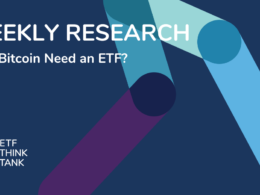ARE YOU AN ETF NERD?
You will be if you read the entirety of this week’s TETF index Weekly Review. Each week we look for interesting facts and figures that can illuminate the factors that contribute to the growth of the ETF ecosystem. Diversification is one of the client alignment growth factors we often cite, and today we explain metrics to quantify diversification. Further, we will apply the same metrics to the business of ETFs and evaluate the competitive position of the top five ETF issuers.
Readers that are ETF Nerds, should join our ETF Think Tank and seek us out at the Inside ETFs conference to receive your honorary pin.
DIVERSIFICATION GALORE
One of the benefits of ETFs is instant diversification in a single ticker. Investors often look to the number of holdings as an indication of how much diversification an ETF provides. However, consider S&P 500 exposure in three ETFs weighted differently: Market Cap (SPDR® S&P 500® ETF, ticker: “SPY”), Equal Weight (Guggenheim S&P 500® Equal Weight ETF, ticker: “RSP”) and Reverse Cap (Reverse Cap Weighted US Large Cap ETF, ticker: “RVRS”). All three possess the exact same 500 securities but provide vastly different returns, exposures, and risk.
This is where the nerd part begins. Investors seeking to understand the true diversification of an ETF must look at more than just the number of constituents and consider the concentration of holdings. A common quantitative measure of concentration is the Herfindahl-Hirschman Index (HHI).
The Herfindahl-Hirschman index (HHI) is a commonly accepted measure of market concentration. It is calculated by squaring the market share of each firm competing in a market, and then summing the resulting numbers, and can range from close to zero to 10,000. Investopedia.
The HHI allows investors to evaluate how much concentration and thereby unintentional factor biases are affecting their returns as illustrated in the comparison below of SPY, RSP, and RVRS:
AVERAGE MARKET CAP AND CONCENTRATION RANKED
This approach allows us to highlight the key difference and diversification benefits between three ETFs that own the same securities.
– SPY is the most concentrated and focuses on the largest companies.
– RSP is the least concentrated but still has an explicit large cap bias.
– RVRS is slightly more concentrated than RSP but captures more of a mid-cap bias.
Investors looking for true diversification would be better served by RSP or RVRS depending on capitalization preferences.
CONCENTRATION OF THE INDUSTRY
Now that we have “Geeked out” on how concentration can be used to evaluate ETFs lets apply the same methodology to the ETF industry. Spoiler alert, it is quite concentrated.
MARKET SHARE
When applying the HHI methodology to the concentration of assets by issuer the score is 2530. Which is an indication of an undiversified industry so far. That said in a previous weekly update we explored the growth rates by issuer which showed superior growth rates for ETF issuers with lower market share. This bodes well for the future growth of the ETF ecosystem.
CONCENTRATION OF ETF PRODUCT BY ISSUER
The HHI methodology can also be used to evaluate the robustness of each issuers ETF business. Below we ranked the ETF assets, number of ETFs and concentration of assets within the products, of the five largest issuers.
TOP 5 ISSUERS CONCENTRATION OF ETF ASSETS
The data shows that two leaders BlackRock and Vanguard have vastly different business models. Vanguard´s success is substantially more concentrated in fewer funds. This implies vulnerability since their primary value proposition is “low fees” within a relatively undiversified product line up. State Street´s business is the most concentrated due to the success of SPY, the Sector SPDRs and GLD. Finally, Schwab stands out as an outlier with serious growth potential; with only 22 ETFs they have become the 5th largest issuer with assets diversified across all proprietary products.
Congratulations, you are an ETF Nerd who can participate in the growth of the ETF industry!
If you would like to learn more about our ETF Think Tank please contact:
Oscar Biondolillo
+ 1 (773) 814-4746
obiondolillo@torosoinv.com
ETF LAUNCHES
- Hartford Municipal Opportunities ETF HMOP
- American Energy Independence ETF USAI
- IQ Chaikin US Large Cap ETF CLRG
- AdvisorShares Vice ETF ACT
- Pacer WealthShield ETF PWS
- Citigroup ETNs lnkd VS Dly 4X Lng USDJPY DJPY
- Citigroup ETNs lnkd VS Dly 4X Lng USDEUR DEUR
- Citigroup ETNs lnkd VS Dly 4X Lng USDGBP DGBP
- Citigroup ETNs lnkd VS Dly 4X Lng USDCHF DCHF
- Citigroup ETNs lnkd VS Dly 4X Lng USDAUD DAUD
- Citigroup ETNs lnkd VS Dly 4X Lng JPYUSD UJPY
- Citigroup ETNs lnkd VS Dly 4X Lng EURUSD UEUR
- Citigroup ETNs lnkd VS Dly 4X Lng GBPUSD UGBP
- Citigroup ETNs lnkd VS Dly 4X Lng CHFUSD UCHF
- Citigroup ETNs lnkd VS Dly 4X Lng AUDUSD UAUD
ETF LAUNCH OF THE WEEK
This week we are spotlighting the first suite of 4X leveraged products from VelocityShares, a division of Janus Henderson (JHG). They launched 10 ETNs that provide four times leverage to ten different currency combinations. Bitcoin is not one of them but it appears investors will now have the ability to embrace the volatility of ten fiat currencies with the most leverage ever seen in the ETF/ETN world.












